Scientometric Analysis-Based Review for Drought Modelling, Indices, Types, and Forecasting Especially in Asia
Abstract
:1. Introduction
2. Methodology
3. Results and Discussion on Scientometric Analysis
3.1. Subject Area and Annual Publication Pattern of Articles
3.2. Keywords Mapping
3.3. Co-Authorship Mapping
3.4. Countries
4. Types of Drought
4.1. Agricultural Drought
4.2. Hydrological Drought
4.3. Meteorological Drought
4.4. Socio-Economic Drought
5. Drought Indices
5.1. Palmer Drought Severity Index
5.2. Surface Water Supply Index
5.3. Percent of Normal Precipitation Index (PNPI)
5.4. Crop Moisture Index
5.5. Standard Precipitation Index
5.6. Evaporative Stress Index
5.7. Vegetation Drought Response Index
5.8. Process-Based Accumulated Drought Index
6. Drought Modelling and Forecasting
6.1. Dynamic Modelling
6.2. Probabilistic Modelling
6.3. Stochastic Modelling
7. Case Study of Asia
7.1. Case Study of China
7.2. Case Study of India
7.3. Case Study of Pakistan
7.4. Case Study Iran
8. Summary and Future Recommendation
- Scientometric analysis of data retrieved from the Scopus database revealed that the top three fields in terms of document count were Environmental Science, Agriculture and Biological Science, and Earth and Planetary Science, accounting for 28 percent, 28 percent, and 27 percent, respectively, of total documents. Up until 2019–2020, a small rise in the number of articles about drought was seen. Moreover, for 2021, data were collected from January -June, which indicate a significant decline in the publications. However, it may be improved in the remaining months of 2021.
- Drought, Asia, climate change, and China are the top four most-occurring terms. Additionally, China, Germany, and the United States supplied the greatest number of papers to the present subject of research. Additionally, with 856 citations, Li j. was the most referenced author.
- Meteorological droughts occur when there is a cumulative deficit of atmospheric precipitation, followed by agricultural droughts, social economic droughts, and hydrological droughts.
- The drought index categorizes droughts based on their meteorological, agricultural, socioeconomic, and hydrological characteristics. It is critical to establish a clear connection between agricultural, meteorological, social economic droughts, and hydrological droughts to reveal transmission patterns and threshold criteria. Additionally, it is critical to carefully monitor droughts and provide early notice when one occurs.
- There is a never-ending endeavor to create resourceful drought indices with the goal of enhancing drought monitoring and creating more accurate drought metrics. Drought indices can only characterize drought conditions using hydrometeorological variables and cannot quantify economic damages, according to the authors.
- Drought research in China continues to confront many obstacles. Drought creation is unique in China, and global warming and fast societal change have exacerbated the issue’s complexity. Drought monitoring using the SPI is widely recognized in Pakistan. In arid and rainfed areas, the SPI frequently does not sufficiently represent drought conditions (such as their onset). Research shows that the GDP has been reduced in India due to a large decrease in food grain production, which corresponds to a large deficit in monsoon rainfall. The geographic analysis of Iran showed that there was a severe drought in the country’s east, southwest, west, and center for many months.
- Three types of modelling techniques, dynamic, probabilistic, and stochastic, are discussed in this study. In drought forecasting, dynamic modelling for real-time forecasting is well-known. Remote-sensing data are often used as an input for dynamic modelling. Another method used probabilistic modelling and Markov chains to predict future drought occurrences based on the likelihood. Similarly, the ARIMA model was discovered for forecasting time series with short lead periods with reasonable accuracy.
Future Recommendations
- Future drought predictions should strive to include the benefits of dynamic modelling, probabilistic, and stochastic forecasting techniques. Due to its ability to identify direct drought effects while filtering out indirect drought effects and their consequences, big data systems are expected to be a future trend in drought modelling.
- In the long run, there should be an emphasis on the relationship between hydrological and meteorological factors, not the time lag between them, which needs further study.
- The method employed and the models used do not take into account the important details of local climates, watershed features, and human influences that are typically needed for drought forecasting in Asia.
- The connection between meteorological, hydrological, soil moisture, and vegetation drought will be investigated in the future with additional quantitative characteristics.
- A basic agent-based drought risk model for smallholder farmers in semi-arid areas will be established.
Author Contributions
Funding
Acknowledgments
Conflicts of Interest
References
- Dai, A. Drought under global warming: A review. Wiley Interdiscip. Rev. Clim. Chang. 2011, 2, 45–65. [Google Scholar]
- Sivakumar, M.; Wilhite, D. Drought preparedness and drought management. In Drought Mitigation and Prevention of Land Desertification; University of Ljubljana: Ljubljana, Slovenia, 2002; pp. 21–25. [Google Scholar]
- Su, B.; Huang, J.; Fischer, T.; Wang, Y.; Kundzewicz, Z.W.; Zhai, J.; Sun, H.; Wang, A.; Zeng, X.; Wang, G. Drought losses in China might double between the 1.5 C and 2.0 C warming. Proc. Natl. Acad. Sci. USA 2018, 115, 10600–10605. [Google Scholar] [CrossRef] [PubMed] [Green Version]
- Ullah, H.; Akbar, M.; Khan, F. Droughts’ projections in homogeneous climatic regions using Standardized Precipitation Index in Pakistan. Theor. Appl. Climatol. 2020, 140, 787–803. [Google Scholar] [CrossRef]
- Ghamghami, M.; Irannejad, P. An analysis of droughts in Iran during 1988–2017. SN Appl. Sci. 2019, 1, 1–21. [Google Scholar] [CrossRef] [Green Version]
- Pal, I.; Al-Tabbaa, A. Regional changes of the severities of meteorological droughts and floods in India. J. Geogr. Sci. 2011, 21, 195–206. [Google Scholar] [CrossRef]
- Apurv, T.; Sivapalan, M.; Cai, X. Understanding the role of climate characteristics in drought propagation. Water Resour. Res. 2017, 53, 9304–9329. [Google Scholar] [CrossRef] [Green Version]
- Svoboda, M.; Hayes, M.; Wood, D. Standardized Precipitation Index User Guide; World Meteorological Organization: Geneva, Switzerland, 2012; 900p. [Google Scholar]
- Van Eck, N.J.; Waltman, L. Software survey: VOSviewer, a computer program for bibliometric mapping. Scientometrics 2010, 84, 523–538. [Google Scholar] [CrossRef] [Green Version]
- Aghaei Chadegani, A.; Salehi, H.; Yunus, M.; Farhadi, H.; Fooladi, M.; Farhadi, M.; Ale Ebrahim, N. A comparison between two main academic literature collections: Web of Science and Scopus databases. Asian Soc. Sci. 2013, 9, 18–26. [Google Scholar] [CrossRef] [Green Version]
- Meho, L.I. Using scopus’s citescore for assessing the quality of computer science conferences. J. Informetr. 2019, 13, 419–433. [Google Scholar] [CrossRef]
- Bo, Y.; Su, M.; Jing, L.; Yufang, L.; Bin, Z.; Kuenzer, C. Agricultural drought monitoring in Dongting Lake Basin by MODIS data. In Proceedings of the 2012 First International Conference on Agro-Geoinformatics (Agro-Geoinformatics), Shanghai, China, 2–4 August 2012; pp. 1–7. [Google Scholar]
- Sepulcre-Canto, G.; Horion, S.; Singleton, A.; Carrao, H.; Vogt, J. Development of a combined drought indicator to detect agricultural drought in Europe. Nat. Hazards Earth Syst. Sci. 2012, 12, 3519–3531. [Google Scholar] [CrossRef] [Green Version]
- Li, R.; Chen, N.; Zhang, X.; Zeng, L.; Wang, X.; Tang, S.; Li, D.; Niyogi, D. Quantitative analysis of agricultural drought propagation process in the Yangtze River Basin by using cross wavelet analysis and spatial autocorrelation. Agric. For. Meteorol. 2020, 280, 107809. [Google Scholar] [CrossRef]
- Mishra, A.K.; Singh, V.P. A review of drought concepts. J. Hydrol. 2010, 391, 202–216. [Google Scholar] [CrossRef]
- Wu, J.; Liu, Z.; Yao, H.; Chen, X.; Chen, X.; Zheng, Y.; He, Y. Impacts of reservoir operations on multi-scale correlations between hydrological drought and meteorological drought. J. Hydrol. 2018, 563, 726–736. [Google Scholar] [CrossRef]
- Estrela, M.; Peñarrocha, D.; Millán, M. Multi-annual drought episodes in the Mediterranean (Valencia region) from 1950–1996. A spatio-temporal analysis. Int. J. Climatol. J. R. Meteorol. Soc. 2000, 20, 1599–1618. [Google Scholar] [CrossRef]
- Hayes, M.; Svoboda, M.; Wall, N.; Widhalm, M. The Lincoln declaration on drought indices: Universal meteorological drought index recommended. Bull. Am. Meteorol. Soc. 2011, 92, 485–488. [Google Scholar] [CrossRef] [Green Version]
- Guo, Y.; Huang, S.; Huang, Q.; Wang, H.; Fang, W.; Yang, Y.; Wang, L. Assessing socioeconomic drought based on an improved multivariate standardized reliability and resilience index. J. Hydrol. 2019, 568, 904–918. [Google Scholar] [CrossRef]
- Huang, S.; Huang, Q.; Leng, G.; Liu, S. A nonparametric multivariate standardized drought index for characterizing socioeconomic drought: A case study in the Heihe River Basin. J. Hydrol. 2016, 542, 875–883. [Google Scholar] [CrossRef]
- Zhang, X.; Chen, N.; Sheng, H.; Ip, C.; Yang, L.; Chen, Y.; Sang, Z.; Tadesse, T.; Lim, T.P.Y.; Rajabifard, A. Urban drought challenge to 2030 sustainable development goals. Sci. Total Environ. 2019, 693, 133536. [Google Scholar] [CrossRef] [PubMed]
- Waseem, M.; Ajmal, M.; Kim, T.-W. Development of a new composite drought index for multivariate drought assessment. J. Hydrol. 2015, 527, 30–37. [Google Scholar] [CrossRef]
- Ozger, M.; Mishra, A.K.; Singh, V.P. Estimating palmer drought severity index using a wavelet fuzzy logic model based on meteorological variables. Int. J. Climatol. 2011, 31, 2021–2032. [Google Scholar] [CrossRef]
- Raziei, T.; Daneshkar Arasteh, P.; Akhtari, R.; Saghafian, B. Investigation of meteorological droughts in the Sistan and Balouchestan province, using the standardized precipitation index and Markov chain model. Iran.-Water Resour. Res. 2007, 3, 25–35. [Google Scholar]
- Wu, H.; Hubbard, K.G.; Wilhite, D.A. An agricultural drought risk-assessment model for corn and soybeans. Int. J. Climatol. J. R. Meteorol. Soc. 2004, 24, 723–741. [Google Scholar] [CrossRef] [Green Version]
- Eslamian, S.; Ostad-Ali-Askari, K.; Singh, V.P.; Dalezios, N.R.; Ghane, M.; Yihdego, Y.; Matouq, M. A review of drought indices. Int. J. Constr. Res. Civ. Eng. 2017, 3, 48–66. [Google Scholar]
- Maca, P.; Pech, P. Forecasting SPEI and SPI drought indices using the integrated artificial neural networks. Comput. Intell. Neurosci. 2016, 2016. [Google Scholar] [CrossRef] [Green Version]
- Pai, D.; Sridhar, L.; Guhathakurta, P.; Hatwar, H. District-wide drought climatology of the southwest monsoon season over India based on standardized precipitation index (SPI). Nat. Hazards 2011, 59, 1797–1813. [Google Scholar] [CrossRef]
- Anderson, M.C.; Zolin, C.A.; Sentelhas, P.C.; Hain, C.R.; Semmens, K.; Yilmaz, M.T.; Gao, F.; Otkin, J.A.; Tetrault, R. The evaporative stress index as an indicator of agricultural drought in Brazil: An assessment based on crop yield impacts. Remote Sens. Environ. 2016, 174, 82–99. [Google Scholar] [CrossRef]
- Zhong, Y.; Otkin, J.A.; Anderson, M.C.; Hain, C. Investigating the relationship between the evaporative stress index and land surface conditions in the contiguous United States. J. Hydrometeorol. 2020, 21, 1469–1484. [Google Scholar] [CrossRef]
- Brown, J.F.; Wardlow, B.D.; Tadesse, T.; Hayes, M.J.; Reed, B.C. The vegetation drought response index (VegDRI): A new integrated approach for monitoring drought stress in vegetation. GIScience Remote Sens. 2008, 45, 16–46. [Google Scholar] [CrossRef]
- Faiz, M.A.; Zhang, Y.; Ma, N.; Baig, F.; Naz, F.; Niaz, Y. Drought indices: Aggregation is necessary or it is only the researcher’s choice. Water Supply 2021. [Google Scholar] [CrossRef]
- Soubry, I.; Guo, X. Monitoring and Modeling Rangeland Health with Remote Sensing; University of Saskatchewan: Saskatoon, SK, Canada, 2020. [Google Scholar]
- Deo, R.C.; Tiwari, M.K.; Adamowski, J.F.; Quilty, J.M. Forecasting effective drought index using a wavelet extreme learning machine (W-ELM) model. Stoch. Environ. Res. Risk Assess. 2017, 31, 1211–1240. [Google Scholar] [CrossRef]
- Dehghani, M.; Saghafian, B.; Rivaz, F.; Khodadadi, A. Evaluation of dynamic regression and artificial neural networks models for real-time hydrological drought forecasting. Arab. J. Geosci. 2017, 10, 1–13. [Google Scholar] [CrossRef]
- Memarian, H.; Bilondi, M.P.; Rezaei, M. Drought prediction using co-active neuro-fuzzy inference system, validation, and uncertainty analysis (case study: Birjand, Iran). Theor. Appl. Climatol. 2016, 125, 541–554. [Google Scholar] [CrossRef]
- Han, P.; Wang, P.X.; Zhang, S.Y. Drought forecasting based on the remote sensing data using ARIMA models. Math. Comput. Model. 2010, 51, 1398–1403. [Google Scholar] [CrossRef]
- Fernández-Manso, A.; Quintano, C.; Fernández-Manso, O. Forecast of NDVI in coniferous areas using temporal ARIMA analysis and climatic data at a regional scale. Int. J. Remote Sens. 2011, 32, 1595–1617. [Google Scholar] [CrossRef]
- Shukla, S.; Lettenmaier, D.P. Multi-RCM ensemble downscaling of NCEP CFS winter season forecasts: Implications for seasonal hydrologic forecast skill. J. Geophys. Res. Atmos. 2013, 118, 10770–10790. [Google Scholar] [CrossRef]
- Bowden, J.H.; Talgo, K.D.; Spero, T.L.; Nolte, C.G. Assessing the added value of dynamical downscaling using the standardized precipitation index. Adv. Meteorol. 2016, 2016, 8432064. [Google Scholar] [CrossRef] [Green Version]
- Sheffield, J.; Wood, E.F.; Chaney, N.; Guan, K.; Sadri, S.; Yuan, X.; Olang, L.; Amani, A.; Ali, A.; Demuth, S. A drought monitoring and forecasting system for sub-Sahara African water resources and food security. Bull. Am. Meteorol. Soc. 2014, 95, 861–882. [Google Scholar] [CrossRef]
- Stagge, J.H.; Kohn, I.; Tallaksen, L.M.; Stahl, K. Modeling drought impact occurrence based on meteorological drought indices in Europe. J. Hydrol. 2015, 530, 37–50. [Google Scholar] [CrossRef]
- Paulo, A.A.; Pereira, L.S. Prediction of SPI drought class transitions using Markov chains. Water Resour. Manag. 2007, 21, 1813–1827. [Google Scholar] [CrossRef]
- Zhang, T.; Li, J.; Hu, R.; Wang, Y.; Feng, P. Drought class transition analysis through different models: A case study in North China. Water Sci. Technol. Water Supply 2017, 17, 138–150. [Google Scholar] [CrossRef]
- Sun, P.; Zhang, Q.; Singh, V.P.; Xiao, M.; Zhang, X. Transitional variations and risk of hydro-meteorological droughts in the Tarim River basin, China. Stoch. Environ. Res. Risk Assess. 2017, 31, 1515–1526. [Google Scholar] [CrossRef]
- Sharma, T.; Panu, U. Prediction of hydrological drought durations based on Markov chains: Case of the Canadian prairies. Hydrol. Sci. J. 2012, 57, 705–722. [Google Scholar] [CrossRef] [Green Version]
- Chen, J.; Yang, Y. SPI-based regional drought prediction using weighted Markov chain model. Res. J. Appl. Sci. Eng. Technol. 2012, 4, 4293–4298. [Google Scholar]
- Mishra, A.; Desai, V.; Singh, V. Drought forecasting using a hybrid stochastic and neural network model. J. Hydrol. Eng. 2007, 12, 626–638. [Google Scholar] [CrossRef]
- Durdu, Ö.F. Application of linear stochastic models for drought forecasting in the Büyük Menderes river basin, western Turkey. Stoch. Environ. Res. Risk Assess. 2010, 24, 1145–1162. [Google Scholar] [CrossRef]
- Wu, J.; Lin, X.; Wang, M.; Peng, J.; Tu, Y. Assessing agricultural drought vulnerability by a VSD model: A case study in Yunnan Province, China. Sustainability 2017, 9, 918. [Google Scholar] [CrossRef] [Green Version]
- Zhexian, R.J.L. Dry climatological Feature on the Loess plateau in view of Rainfall in China. Agric. Res. Arid Areas 1989, 2. Available online: https://en.cnki.com.cn/Article_en/CJFDTotal-GHDQ198902004.htm (accessed on 1 September 2021).
- Wang, C.; Yang, K.; Li, Y.; Wu, D.; Bo, Y. Impacts of spatiotemporal anomalies of Tibetan Plateau snow cover on summer precipitation in eastern China. J. Clim. 2017, 30, 885–903. [Google Scholar] [CrossRef]
- Zhang, Q.; Qi, T.; Singh, V.P.; Chen, Y.D.; Xiao, M. Regional frequency analysis of droughts in China: A multivariate perspective. Water Resour. Manag. 2015, 29, 1767–1787. [Google Scholar] [CrossRef]
- Han, L.; Zhang, Q.; Yao, Y.; Li, Y.; Jia, J.; Wang, J. Characteristics and origins of drought disasters in Southwest China in nearly 60 years. Acta Geogr. Sin. 2014, 69, 632–639. [Google Scholar]
- Avadi, S.; Seth, R. Positing Indian military for disaster response: Comparative analysis of military involvement pre-and post-adoption of National Disaster Management Framework 2005. Def. Stud. 2020, 20, 123–142. [Google Scholar] [CrossRef]
- Pritchard, H.D. Asia’s glaciers are a regionally important buffer against drought. Nature 2017, 545, 169–174. [Google Scholar] [CrossRef]
- Kala, C.P. Save Ganga campaign and hydroelectric projects in Uttarakhand. Curr. Sci. 2011, 101, 596. [Google Scholar]
- Thompson, L.G.; Yao, T.; Mosley-Thompson, E.; Davis, M.; Henderson, K.; Lin, P.-N. A high-resolution millennial record of the South Asian monsoon from Himalayan ice cores. Science 2000, 289, 1916–1919. [Google Scholar] [CrossRef] [Green Version]
- Kala, C.P. Environmental and socioeconomic impacts of drought in India: Lessons for drought management. Sci. Educ. 2017, 5, 43–48. [Google Scholar]
- Gadgil, S.; Gadgil, S. The Indian monsoon, GDP and agriculture. Econ. Political Wkly. 2006, 41, 4887–4895. [Google Scholar]
- Hassan, M. Water security in Pakistan: Issues and challenges. United Nations Dev. Programme Pak. 2016, 3, 1–34. [Google Scholar]
- Xie, H.; Ringler, C.; Zhu, T.; Waqas, A. Droughts in Pakistan: A spatiotemporal variability analysis using the Standardized Precipitation Index. Water Int. 2013, 38, 620–631. [Google Scholar] [CrossRef]
- Ibrahim, K.; Zin, W.Z.W.; Jemain, A.A. Evaluating the dry conditions in Peninsular Malaysia using bivariate copula. Anziam J. 2009, 51, C555–C569. [Google Scholar] [CrossRef] [Green Version]
- Leasor, Z.T.; Quiring, S.M.; Svoboda, M.D. Utilizing objective drought severity thresholds to improve drought monitoring. J. Appl. Meteorol. Climatol. 2020, 59, 455–475. [Google Scholar] [CrossRef]
- Zengir, V.S.; Sobhani, B.; Asghari, S. Monitoring and investigating the possibility of forecasting drought in the western part of Iran. Arab. J. Geosci. 2020, 13, 1–12. [Google Scholar]
- Yazdani, M.; Sobhani, B.; Zengir, V.S.; Gilandeh, A.G. Analysis, monitoring and simulation of dust hazard phenomenon in the northern Persian Gulf, Iran, Middle East. Arab. J. Geosci. 2020, 13, 1–13. [Google Scholar] [CrossRef]
- hasan Yazdani, M.; Amininia, K.; Safarianzengir, V.; Soltani, N. Analyzing climate change and its effects on drought and water scarcity (case study: Ardabil, Northwestern Province of Iran, Iran). Sustain. Water Resour. Manag. 2021, 7, 1–10. [Google Scholar]
- Sari-Saraf, B.; Vaezihir, A.; Valaei, A.; Abtahi, V. Detection of meteorological and hydrological droughts in the south east of Lake Urmia. J. Environ. Risks 2017, 5, 42-25. [Google Scholar]
- Marj, A.F.; Abadi, F.H.H. A nine-step approach for developing and implementing an “agricultural drought risk management plan”; case study: Alamut River basin in Qazvin, Iran. Nat. Hazards 2020, 102, 1187–1205. [Google Scholar] [CrossRef]

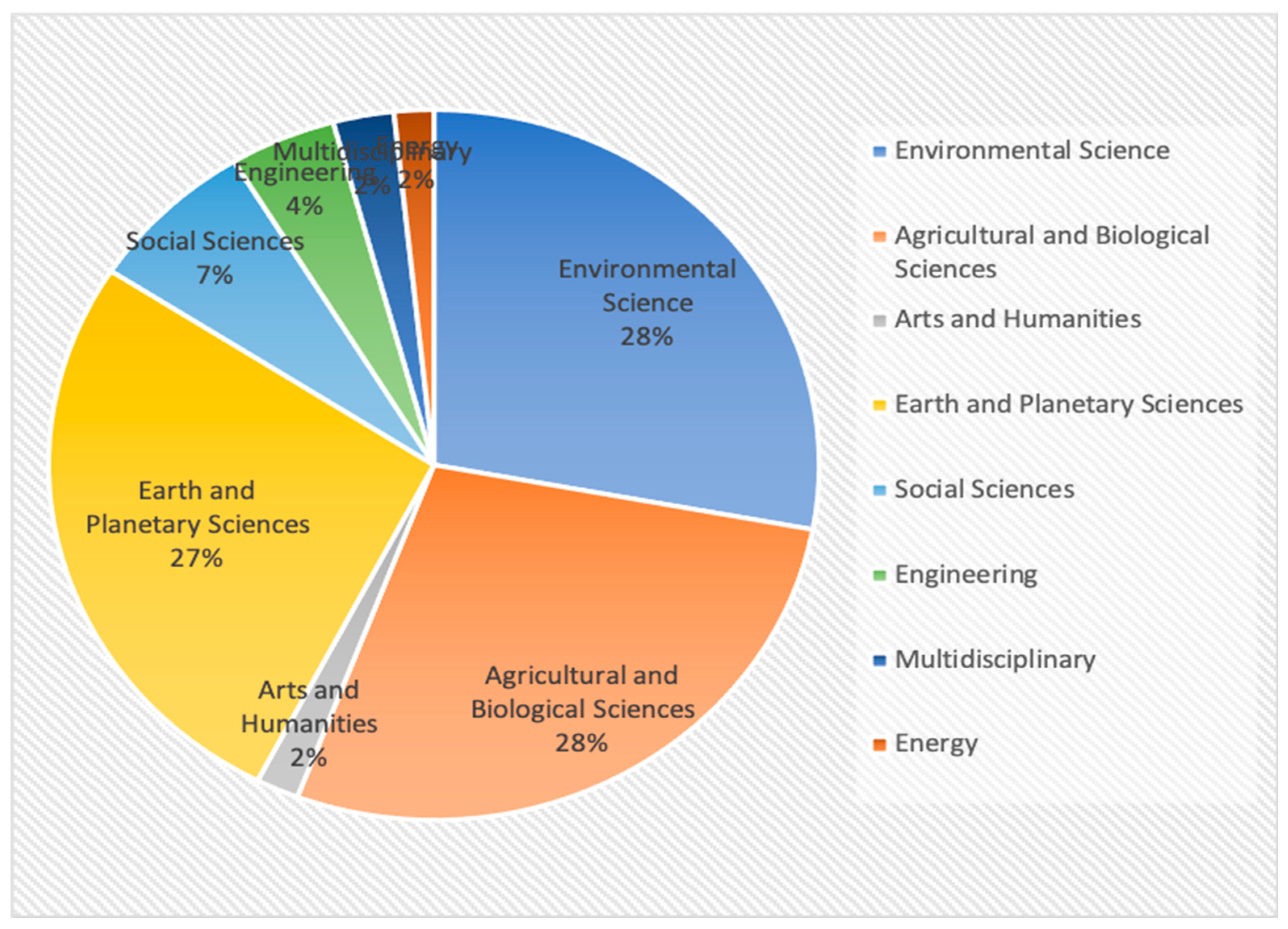
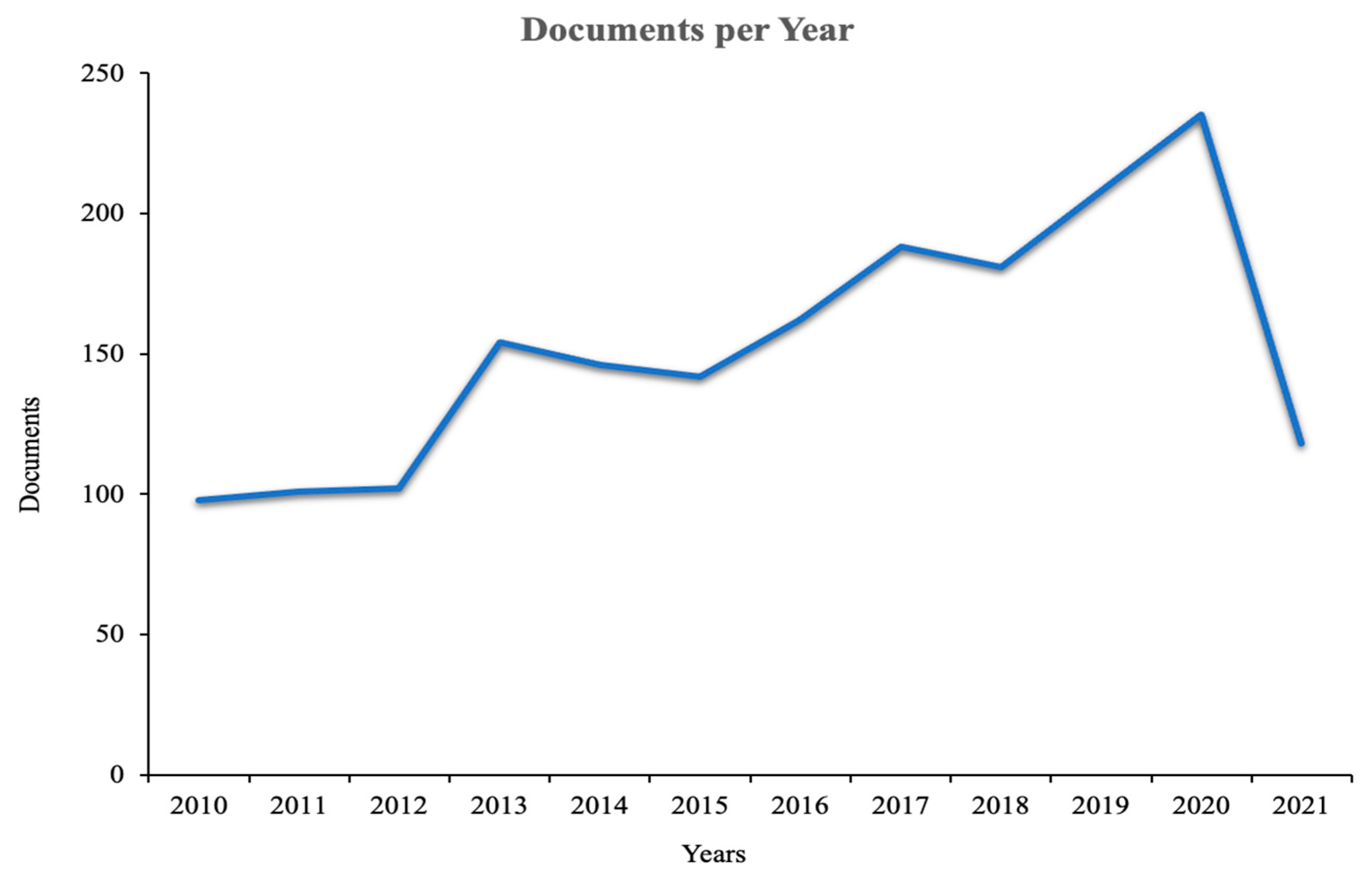
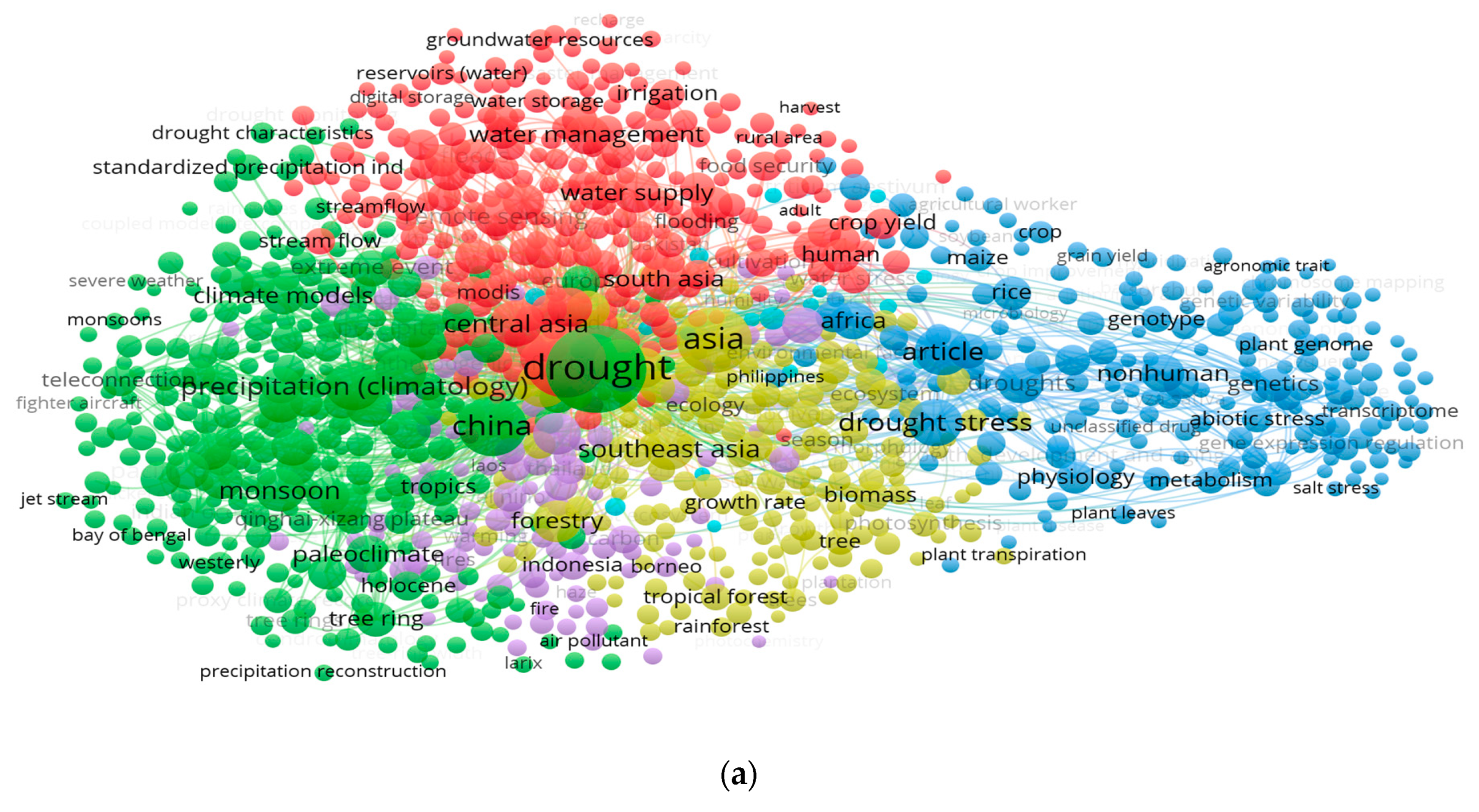
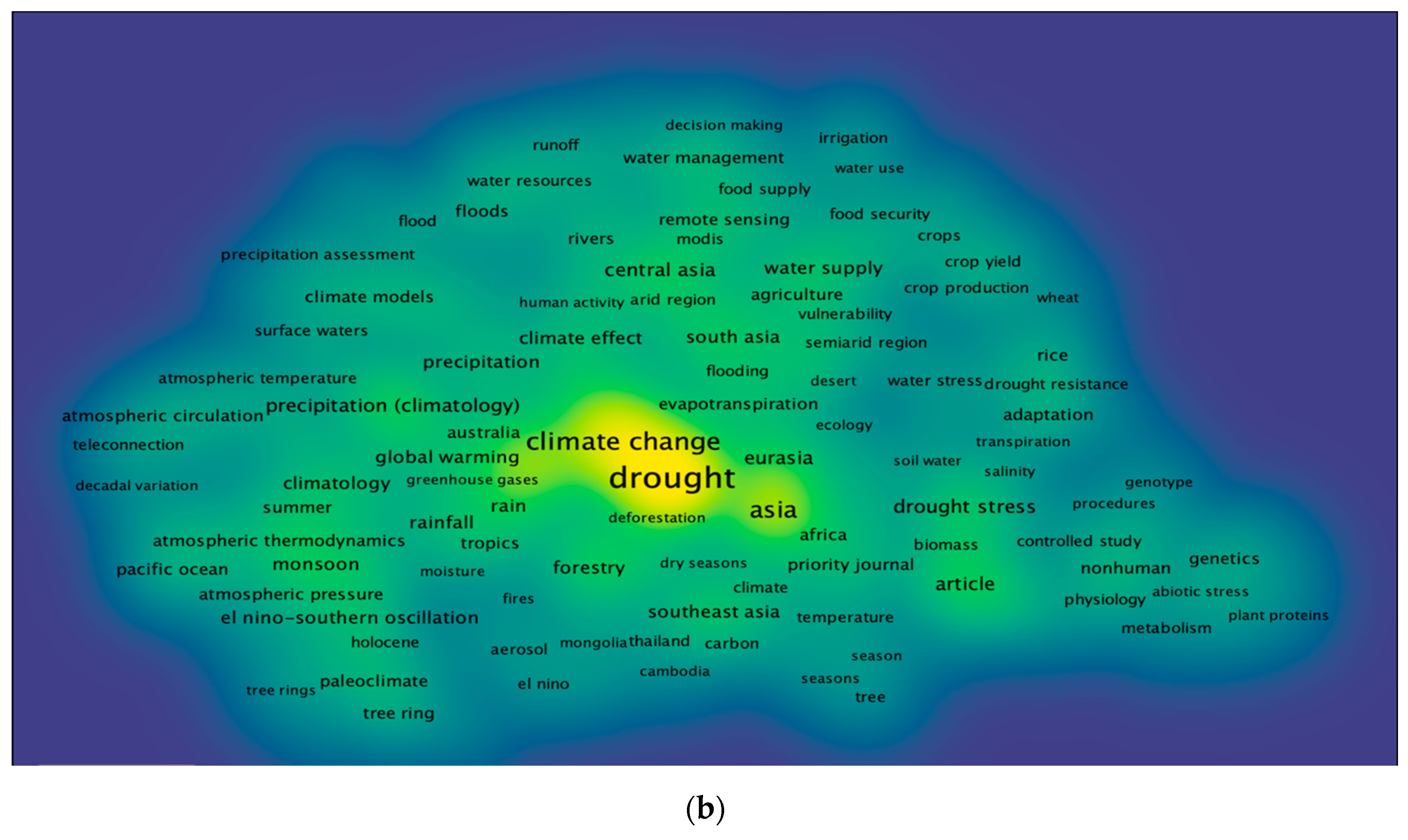
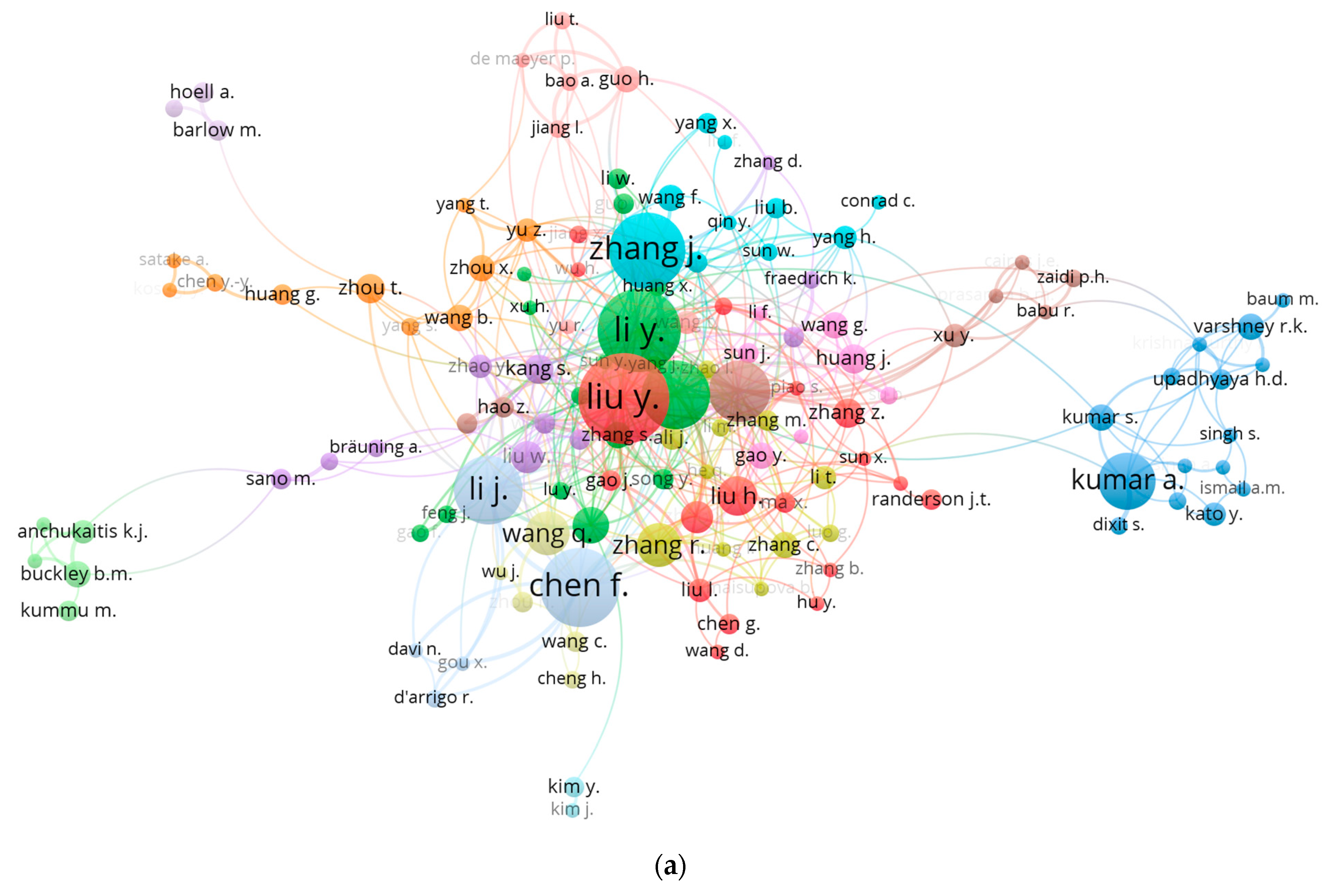
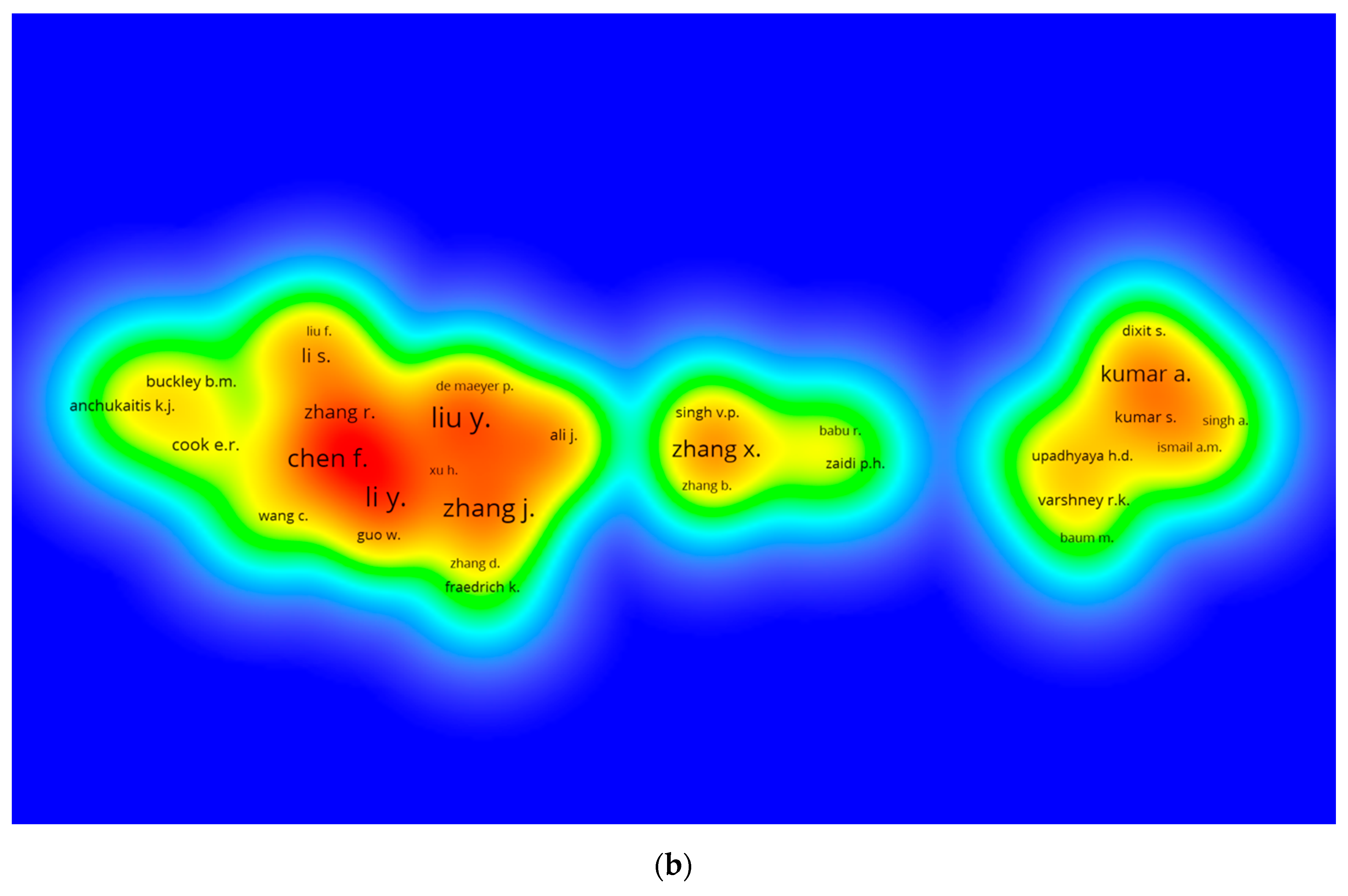
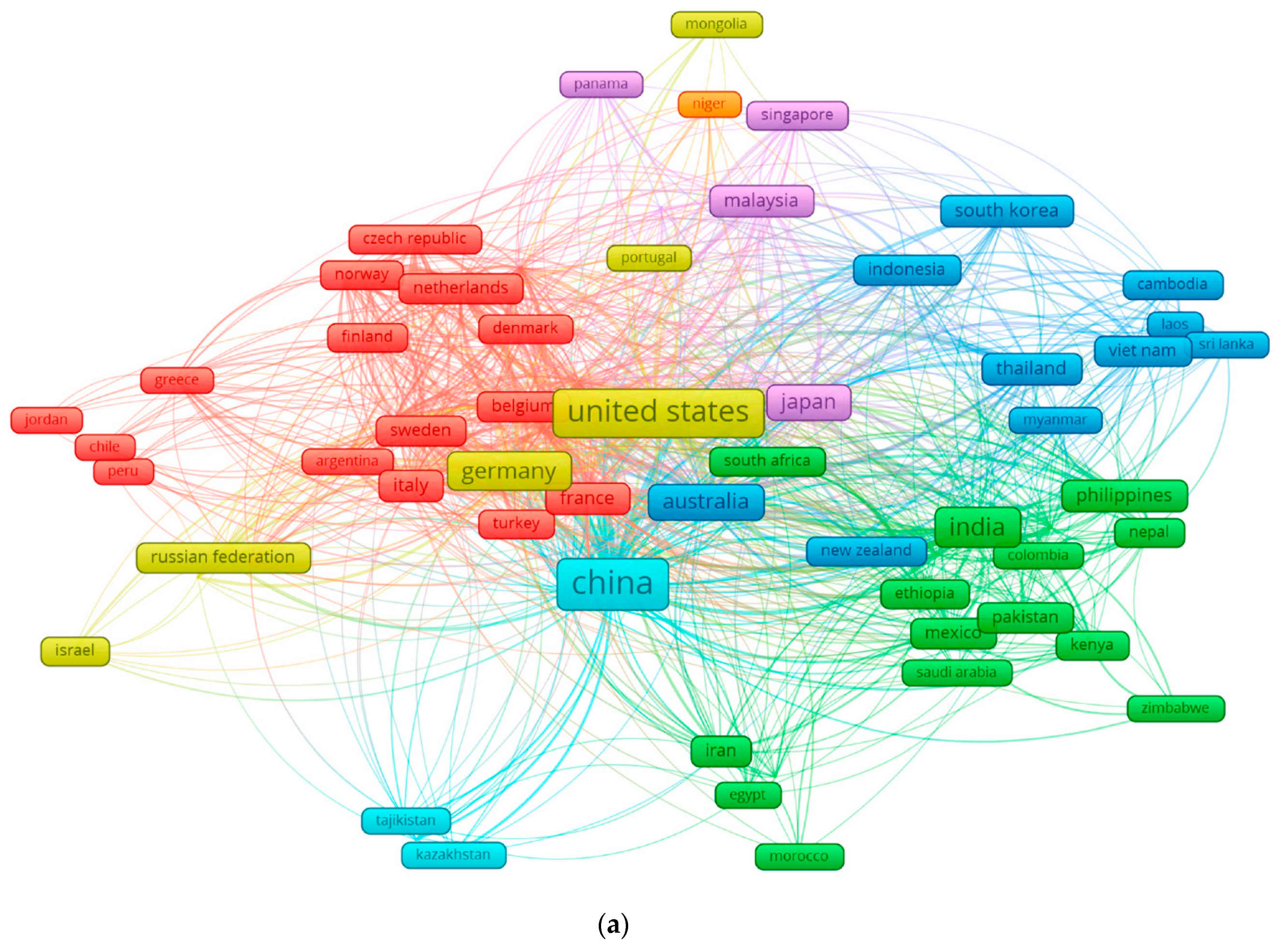
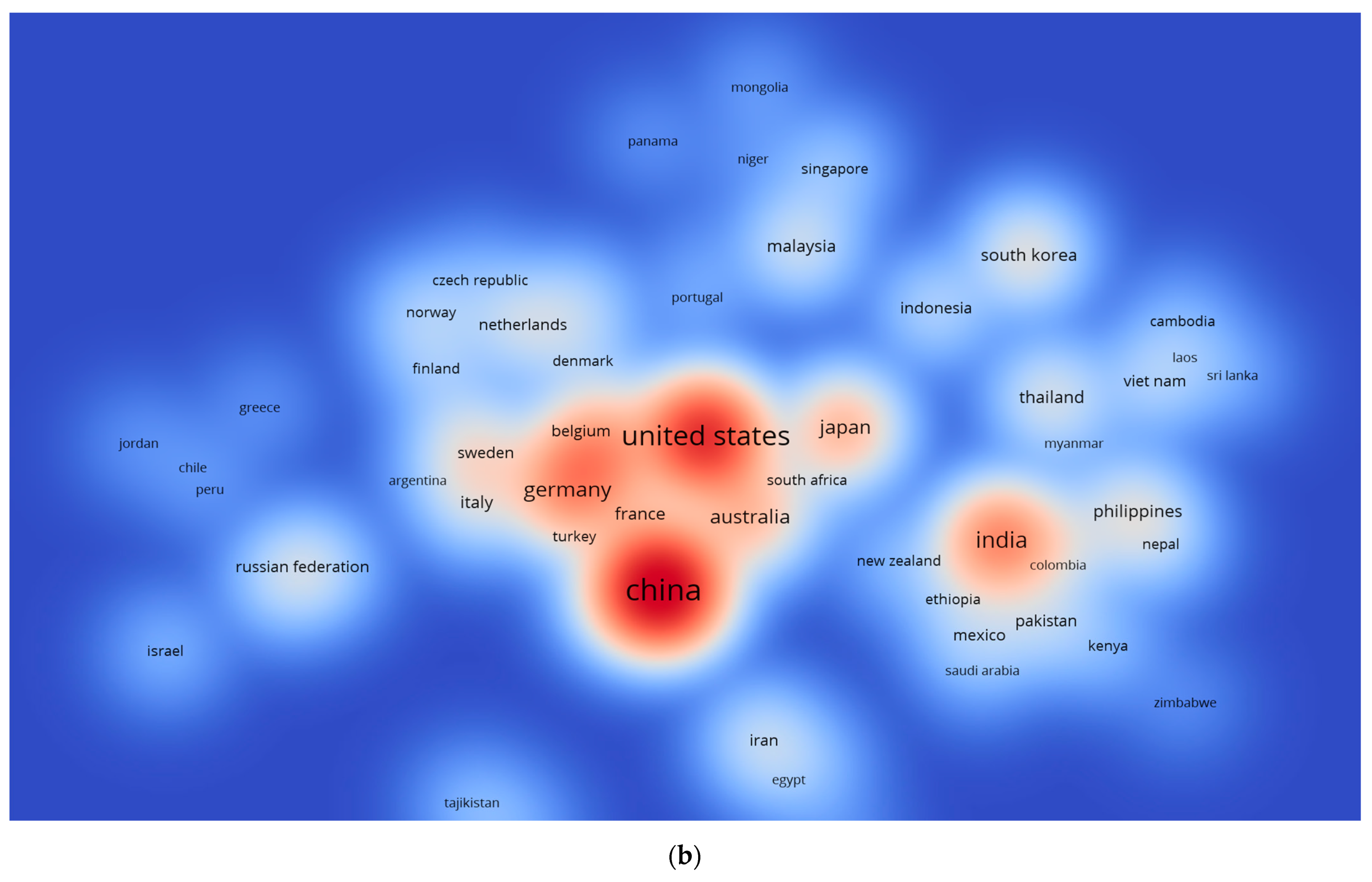
| Keyword | Occurrences | Total Link Strength |
|---|---|---|
| Drought | 920 | 2257 |
| Asia | 398 | 1310 |
| Climate change | 513 | 1263 |
| China | 320 | 978 |
| Eurasia | 153 | 648 |
| Article | 189 | 629 |
| Precipitation | 187 | 621 |
| Far east | 151 | 586 |
| Rain | 137 | 496 |
| Seasonal variation | 115 | 450 |
| Monsoon | 132 | 435 |
| Drought stress | 173 | 412 |
| Southeast Asia | 136 | 403 |
| Droughts | 111 | 398 |
| Rainfall | 109 | 396 |
| Forestry | 120 | 380 |
| Water supply | 110 | 369 |
| El Nino-southern oscillation | 111 | 363 |
| South Asia | 119 | 338 |
| Central Asia | 154 | 330 |
| Author | Documents | Citations | Total Link Strength |
|---|---|---|---|
| dai a | 5 | 2527 | 19 |
| cook e.r. | 11 | 1384 | 27 |
| anchukaitis k.j. | 9 | 1383 | 18 |
| buckley b.m. | 9 | 1311 | 17 |
| randerson j.t. | 7 | 1010 | 5 |
| darrigo r.d | 5 | 1009 | 10 |
| liu y. | 35 | 906 | 67 |
| li j. | 26 | 856 | 72 |
| chen j. | 17 | 855 | 32 |
| li y. | 32 | 846 | 71 |
| chen y. | 21 | 837 | 28 |
| kumar a. | 21 | 809 | 15 |
| zhou t. | 10 | 798 | 61 |
| zhang j. | 29 | 783 | 15 |
| li s. | 17 | 633 | 32 |
| zhang q. | 15 | 610 | 27 |
| li x. | 27 | 560 | 57 |
| chen x. | 21 | 600 | 43 |
| Country | Documents | Citations | Total Link Strength |
|---|---|---|---|
| China | 668 | 14,396 | 227,494 |
| United states | 482 | 19,625 | 203,129 |
| Germany | 192 | 5693 | 103,144 |
| United Kingdom | 161 | 5555 | 78,391 |
| Australia | 140 | 3795 | 66,910 |
| India | 242 | 5152 | 58,147 |
| Japan | 153 | 3494 | 55,803 |
| Sweden | 49 | 1521 | 44,583 |
| South Korea | 82 | 940 | 34,951 |
| France | 65 | 2206 | 33,035 |
| Italy | 54 | 3676 | 32,569 |
| Spain | 37 | 1426 | 32,306 |
| Netherlands | 52 | 2598 | 30,520 |
Publisher’s Note: MDPI stays neutral with regard to jurisdictional claims in published maps and institutional affiliations. |
© 2021 by the authors. Licensee MDPI, Basel, Switzerland. This article is an open access article distributed under the terms and conditions of the Creative Commons Attribution (CC BY) license (https://creativecommons.org/licenses/by/4.0/).
Share and Cite
Wu, D.; Li, Y.; Kong, H.; Meng, T.; Sun, Z.; Gao, H. Scientometric Analysis-Based Review for Drought Modelling, Indices, Types, and Forecasting Especially in Asia. Water 2021, 13, 2593. https://doi.org/10.3390/w13182593
Wu D, Li Y, Kong H, Meng T, Sun Z, Gao H. Scientometric Analysis-Based Review for Drought Modelling, Indices, Types, and Forecasting Especially in Asia. Water. 2021; 13(18):2593. https://doi.org/10.3390/w13182593
Chicago/Turabian StyleWu, Dan, Yanan Li, Hui Kong, Tingting Meng, Zenghui Sun, and Han Gao. 2021. "Scientometric Analysis-Based Review for Drought Modelling, Indices, Types, and Forecasting Especially in Asia" Water 13, no. 18: 2593. https://doi.org/10.3390/w13182593





